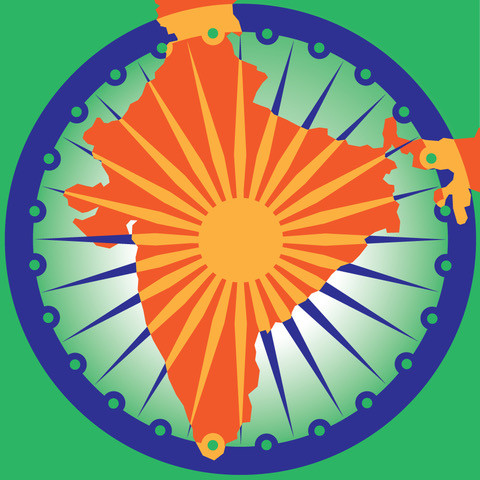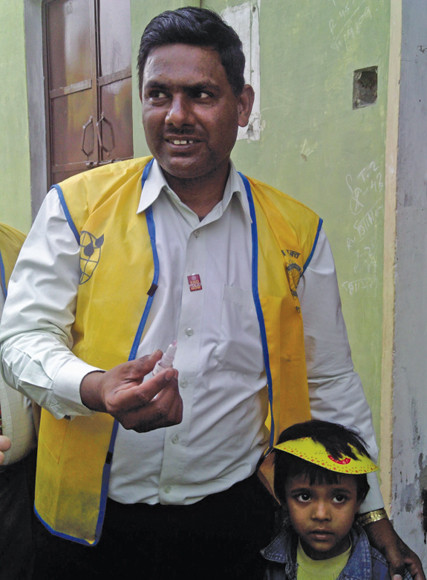
In the state of Uttar Pradesh in northern India, nearly 500,000 children are born every month. And for the Global Polio Eradication Initiative (GPEI), each one must be immunized for polio. Actually, all children under the age of 5 are vaccinated in each polio round, which takes place monthly in high-risk areas. That’s 170 million children vaccinated each year—quite a feat.
To accomplish this, an army of health workers, from the World Health Organization (WHO), UNICEF, and the Indian government, blanket Uttar Pradesh’s high-risk areas with polio booths and door-to-door visits. After 27 years, their efforts have begun to pay off. Last year, India didn’t report a single new case of the disease.
In fact, the last confirmed case of poliomyelitis was an 18-month-old girl from the Howrah district of Kolkata in West Bengal—far from the hotbed of polio. To date, the focus has been on Uttar Pradesh and Bihar, two states known for dense population, low incomes, and poor sanitation. Just three years ago, decades into the campaign, Uttar Pradesh and Bihar still produced more than 700 cases of polio. In 1985, when GPEI began, India had 150,000 cases.
 Mohd Umar, polio
coordinator for Uttar
Pradesh, makes his
rounds with a recently
vaccinated child. (Photo by Esha Chhabra)
Mohd Umar, polio
coordinator for Uttar
Pradesh, makes his
rounds with a recently
vaccinated child. (Photo by Esha Chhabra)
Driving from Delhi to Uttar Pradesh, it’s easy to see how disease can spread. People are in constant supply. The state has a population of approximately 200 million people, or two-thirds of the US population. They live with an endless maze of open sewers, piles of trash, and pools of stagnant water; it’s evident why polio survived for so many years here. Transmitted through contact with fecal matter, the virus can survive in the gut for a month, without showing any signs. An infected child can infect 200 more in the area, and the cycle continues, enveloping a community quickly.
That’s why India’s polio-free year has made headlines globally. Although India’s neighbors Afghanistan and Pakistan, along with Nigeria, continue to be polio-endemic countries, India has now been taken off that list. Even with the burgeoning population, migratory challenges, contaminated water supply, and poor infrastructure, India has succeeded.
“No one thought it could be done here, given the circumstances,” says Rod Curtis, communications development specialist for UNICEF. “So if Uttar Pradesh and Bihar can do it, that’s a strong indicator for other regions battling this as well.”
Although health workers are quietly celebrating, the journey to becoming polio-free has been long and strenuous. The key has been the multilayered, weblike infrastructure of partners, donors, and health workers that make up the GPEI in India. While UNICEF works primarily on communication (posters, coordinating health workers, and informing the public), WHO provides its medical expertise, testing stool samples for possible polio cases, checking polio booths, tracking the virus, and maintaining the correct conditions for the supply of the vaccine. Rotary International, the third partner, has taken the polio campaign to an international stage, raised funds for it, and pressed public officials to make it a priority. The Bill & Melinda Gates Foundation and the Indian government round out this collaboration, along with the US Centers for Disease Control and Prevention.
The immensity of the Indian campaign can be hard to grasp. There are more than 700,000 vaccination booths in every campaign led by 2.5 million vaccinators, who have 2 million vaccine carrier bags, which are kept cool with 6.3 million ice packs. In one national polio round, more than 200 million homes were visited and more than 170 million children were vaccinated. Because of the breadth of the campaign, funding is essential. Most recently, the Gates Foundation pledged $355 million and Rotary International provided more than $200 million.
The immensity of the Indian campaign is hard to grasp. There are 700,000 vaccination booths led by 2.5 million vaccinators, who have 2 million vaccine carrier bags, kept cool with 6.3 million ice packs.
India stands out among the other polio-endemic countries in another way: The Indian government has contributed nearly $2 billion to the effort. Government support comes from the national level—including President Pratibha Patil, who launched this year’s National Immunization Day, and Prime Minister Manmohan Singh, who opened the 2012 Rotary Polio Summit in Delhi—as well as from district-level magistrates, who participate in immunization rounds and meet with health workers for regular assessments.
Additional buy-in has come from UNICEF community mobilizers, government-sponsored ASHA (Accredited Social Health Activists) workers, local WHO staff, and religious leaders. At the microlevel, WHO staff and UNICEF workers meet regularly, exchanging information, coordinating efforts, and identifying trouble spots. The dialogue is constant, especially during immunization rounds, with debriefing sessions taking place every evening.
This web of coordination and collaboration has enabled GPEI to penetrate dense neighborhoods, remote villages, and makeshift colonies, eradicating one of the most dreaded childhood diseases in human history. It is an infrastructure that now can serve as a blueprint for future public health campaigns.
Grassroots Buy-In
I first visited one of north India’s high-risk areas in 2008. It was a four-hour car ride from Delhi on Uttar Pradesh’s potholed roads to Aligarh—a city with polio cases as well as resistance to the vaccine. Health workers found resentful families unwilling to get their children vaccinated. The reasons tended to arise from safety concerns: Among Muslims, a rumor had spread that the vaccine would make their children impotent and was a ploy to minimize their community. It was baseless. But the damage was severe, as more polio cases were found among Muslims with an increasing number of parents forgoing regular visits to the polio vaccination booths.
To combat the false rumor, the Rotary polio office in Delhi consulted with the National Ulema (Muslim clerics), encouraging them to show their support for the vaccine. The clerics complied. They wrote notes of affirmation, in the local language (Urdu), which were used by health workers to convince hesitant families that the vaccine was safe.
Four years later, these kinds of problems have dissipated. In 2012, as I walked through the same neighborhoods with Mohd Umar, the local polio coordinator, health workers came to greet him, mothers said hello, and children swarmed around him. As he took me through some of the same alleys, each house was marked with chalk, indicating that the children there had been vaccinated. Today there’s little resistance to the health incursion. Rather, the locals talk about the water supply and the pumps provided by local politicians, adorned with their party symbol. Some of the pumps are clean; others are sitting amidst piles of garbage, pools of stagnant water, and animal waste.
The dusty alleys, bordered with makeshift homes, lead to a pool of standing water in the heart of the community. It’s already knee-high, and it’s only February. When the monsoon rains come, it will rise. Umar pauses. He knows that even if polio is eradicated from India, dirty water will continue to pose a threat.
Indeed, dirty water has been an encumbrance to the polio effort. Because children are prone to getting dysentery from contaminated water, they struggle to keep the vaccine in their bodies. It quickly passes through them. As a result, children have to be vaccinated repeatedly.
Health workers walk with chalk and black ink here. They chalk the doors, signaling that a house has been reached, and ink the pinky finger of the child, letting other health workers know that he or she has received the vaccine. The teams set up booths through the town. They’re simple constructions: a bench and a table with a polio banner or simply the front of a shop, adorned with a polio poster. In addition, health workers station themselves at train stations, migration points, and other populous locations, searching for that uninked pinky. “Here children cannot be tracked. They don’t go to school. They move where their parents move,” says Umar.
This migratory population is what concerns the polio team. Nima Chodon, communications officer of the India National Rotary PolioPlus Office, explains that these migrations can lead to flareups. The last case of polio in Kolkata was traced back to Delhi and finally to Bihar. Flare-ups have been a recurrent trend in the polio story. Although health workers are able to contain it in one region, it tends to return elsewhere. Last year’s flare-ups in the Congo and Central Asia have all been linked back to India, and in particular to Bihar. To combat this, vaccinations are taking place along the Nepal and Pakistan borders, and WHO is regularly testing the environment in Delhi to see if the virus is on the move.
Among this army of health workers is Dr. Aikant Bhatti, whom I met on National Immunization Day as he was surveying the neighborhoods of West Delhi. A young man who walks fast, speaks with passion, and works efficiently, he is a good example of GPEI’s grassroots support. Asked why he didn’t leave his post as a surveillance medical officer at WHO and take up a more lucrative or prestigious profession, he smiles and says simply, “Once you come out here and you do this, you can’t really walk away from it.”
Many wonder whether India’s success can be repeated in neighboring Afghanistan and Pakistan, where polio still lurks. Dr. Arvind Singhal, a member of the Independent Monitoring Board for GPEI, is optimistic. “In India, GPEI relied on local buy-in, getting members of the local community and religious groups to help. And they slowly chipped away at the resistance. The same local buy-in is needed in the other polio-endemic countries, where they are facing resistance.”
Tim Peterson, a polio expert with the Gates Foundation, echoed that sentiment. “For the kind of noncompliance that we’re seeing in Nigeria right now and the mistrust in Pakistan and Afghanistan, we need to understand why the vaccinators are being refused. In India, we did that. We understood exactly why certain children were being missed. We kept going back to them until we figured it out. So we need to raise the quality of the campaign to that level in the other countries and really get a deep understanding of what’s missing.”
Support SSIR’s coverage of cross-sector solutions to global challenges.
Help us further the reach of innovative ideas. Donate today.
Read more stories by Esha Chhabra.

